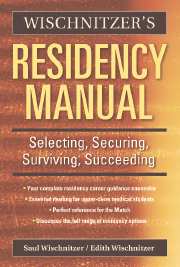Book contents
- Frontmatter
- Contents
- Tables and Forms
- Preface
- Message to the Reader
- Abbreviations
- PART ONE SELECTING A SPECIALTY
- 1 Considering Your Options
- 2 Selecting Your Specialty
- 3 Major Specialties
- 4 Medical Subspecialties
- 5 Surgical Subspecialties
- 6 Other Subspecialties
- PART TWO SECURING A RESIDENCY
- PART THREE SURVIVING A RESIDENCY
- PART FOUR SUCCEEDING IN PRACTICE
- Appendix 1 Major Professional Organizations
- Appendix 2 Sample Resumes
- Appendix 3 Personal Statement
- Glossary
- Bibliography
- Index
4 - Medical Subspecialties
Published online by Cambridge University Press: 08 August 2009
- Frontmatter
- Contents
- Tables and Forms
- Preface
- Message to the Reader
- Abbreviations
- PART ONE SELECTING A SPECIALTY
- 1 Considering Your Options
- 2 Selecting Your Specialty
- 3 Major Specialties
- 4 Medical Subspecialties
- 5 Surgical Subspecialties
- 6 Other Subspecialties
- PART TWO SECURING A RESIDENCY
- PART THREE SURVIVING A RESIDENCY
- PART FOUR SUCCEEDING IN PRACTICE
- Appendix 1 Major Professional Organizations
- Appendix 2 Sample Resumes
- Appendix 3 Personal Statement
- Glossary
- Bibliography
- Index
Summary
Overview
There was a time, more than a century ago, when a senior European professor at a medical school was considered a repository of all the knowledge that existed. Such professors were believed to be qualified to teach a wide gamut of subjects in both the basic sciences and clinical areas of medicine. Initial scientific advances in the early part of the 1900s resulted in the therapeutic option becoming separated into two distinct directions, medicine and surgery. Over time, the volume of knowledge regarding all of the body's principal systems and major illnesses dramatically increased. Consequently subspecialization ultimately became inevitable. This development is an ongoing process, with new areas continually evolving (see Chapter 6). Thus, subspecialists have, by virtue of their advanced training, a high degree of expertise in a specific area. Subspecialty training may be secured in the course of a residency or fellowship. Some subspecialties may be organ-specific (e.g., cardiology or nephrology), whereas others are disease-specific (e.g., oncology or rheumatology). Training in the different subspecialties may vary in length and some may require prior PGY-1 preparation.
Characteristics
Table 4.1 summarizes the characteristics of the medical subspecialties. A detailed discussion of each follows.
The choices
Each of 13 medical subspecialties will be discussed below.
Allergy and immunology
Status: Subspecialty of medicine and pediatrics
Projected need: Somewhat above average
Securing a residency: Not competitive
Training programs: Ca. 70
Positions open: Ca. 224 (women residents ca. 150)
Training period: Two-year fellowship (after a three-year residency)
Weekly patient contact hours: Below average
Attaining patients: Primarily by referral
Remuneration: Starting, below average; median, below average
[…]
- Type
- Chapter
- Information
- Wischnitzer's Residency ManualSelecting, Securing, Surviving, Succeeding, pp. 56 - 77Publisher: Cambridge University PressPrint publication year: 2006



